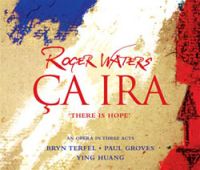|
Ça Ira (opera)
Ça Ira (French for "It will be all right", subtitled "There is Hope") is an opera by Roger Waters. It comes in three acts and is a concept album. The album is based on the French libretto co-written by Étienne and Nadine Roda-Gil on the historical subject of the early French Revolution. Ça Ira was released 26 September 2005, as a double CD album featuring baritone Bryn Terfel, soprano Ying Huang, and tenor Paul Groves.[3][4][5] The album received mixed reviews, with critics praising the composition but criticising its plot and simplicity. HistoryWaters, known for his work in the English rock band Pink Floyd, was approached by friends Étienne Roda-Gil and his wife Nadine Delahaye in 1987, and asked to set their libretto to music. The initial version was completed and recorded by the end of 1988. On hearing it, an impressed François Mitterrand urged the Paris Opera to stage it for the bicentennial of the revolution the following July. The opera directors, however, were resistant. "It foundered on French chauvinism," Waters suggested. "The idea of an English bass player from a pop group creating something they might use in their celebrations stuck in the Gallic craw."[6] Starting in 1989, Waters rewrote the libretto in English.[5] Critical reactionÇa Ira has received mixed reviews. The biggest criticisms were that the opera is too narrative, which makes staging very difficult – and, as a result, disrupts the flow of the piece. Others have complained that the score is too conventional and that Waters should have taken more risks with it.[7] PerformancesThe first time any part of Ça Ira was heard in public was on 16 October 2002 when the Overture was performed live at the Royal Albert Hall in London[8] by the Royal Philharmonic Concert Orchestra, during a benefit gala for the Countryside Alliance.[9] The next public airing (not a live performance, but a recording played through a sound system) took place in Malta on 1 May 2004,[10] the night that Malta entered the European Union. An approximately 15-minute-long excerpt was heard by 80,000 people present at the waterfront of the Grand Harbour. The music was accompanied by a light show by Gert Hoff.[11] The official premiere took place in Rome on 17 November 2005, in front of a sold-out crowd, and was followed the next evening by another performance. Both shows were praised for the high quality of music, vocal performances, and sound. The choir, orchestra, and soloists were complemented by a projection screen backdrop which displayed images (some photographed by Mark Holthusen) helping to tell the story.[12] A full operatic performance took place on 25 August 2006 in Poznań, Poland, and was televised live on Poland's TVP. The project involved the same number of musicians from the concert performances in addition to more than 200 dancers from the Great Theatre in Poznań. There were also period elements of stage design (such as horses, carriages and war scenes with soldiers and stunt performers) and full costumes. Over 500 artists were involved, and the production reportedly cost in excess of €2 million.[13] Performances were held in Kyiv on 16 December, and at the Poznań Opera House on 30 and 31 December 2006.[14] In April 2008, the opera was performed, with the libretto in English, as part of the Festival Amazonas de Ópera in Manaus, Brazil by the Amazonas Philharmonic Orchestra and choir.[15] Dates
RecordingsThe 2005 release was available in three formats:[9]
"I have no idea how many people it will appeal to," Waters remarked. "There's no way it's going to appeal to people in the [same] way [as] Dark Side of the Moon. It's a different animal. I'd like to say I don't care, but obviously I do."[24] In the event, the album spent 14 weeks on Billboard's Classical Chart in the United States and peaked at number 5.[25] Track listing: Disc one
Act 1
Act 2
Track listing: Disc twoAct 3
Charts and certifications
References
|
|||||||||||||||||||||||||||||||||||||||||||||||||||||||||||||||||||||||||||||||||||||||||||||||||||||||||||||||||||||
